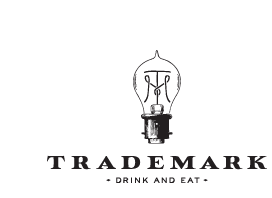Can You Trademark the word Trademark?
Can you actually Trademark the word Trademark? Or would the United States Patent and Trademark Office (USPTO) reject such a claim? A friend of mine recently and posted a picture of what I think is a great trademark. “Trademark” is a restaurant and bar located in Alexandria, not far from the USPTO. Here is its logo:

This nice design gives a nod to the nearby Patent and Trademark office, which presumably employs many of its customers. I can’t help but like the patent illustration style of the artwork, even if it is somewhat unrelated to trademarks. The filaments even make the letters “T” and “M”. For the location it is in, this is no doubt a great trademark. It also is a perfect illustration of a strong trademark.
The Strongest Marks Are Arbitrary
We’ve previously talked about what makes a mark strong. To summarize, generic or descriptive marks are weak and cannot be registered. Marks that suggest the good or service are sufficiently distinct to allow registration. And marks that are arbitrary or fanciful–that is, marks that seemingly have no connection to the goods or services they are associated with–are the strongest type of mark.
“Trademark” is my new favorite example of an arbitrary mark. When I saw the mark, I immediately imagined the following conversation taking place between the restaurant owner and her lawyer:
Owner: I want to trademark the name of my restaurant.
Lawyer: Great! What’s it called?
Owner: It’s called “Restaurant Eat and Drink”
Lawyer: You can’t trademark that for a restaurant. It’s descriptive.
Owner: What do you mean I can’t trademark it? That’s the name of my restaurant!
Lawyer: It just describes your business. If you were allowed to trademark that, nobody could call their restaurants restaurants. You’ll have to change it if you want to register it.
Owner: Well what should I change it to?
Lawyer: I don’t know. It’s your business. But whatever you pick it can’t be descriptive. Pick something that has nothing to do with food.
Owner: Well, trademarks have nothing to do with food. Let’s call it “Trademark”!
And thus a great new trademark was born.
Trademarking the word “Trademark”
Ironically, the “Trademark” restaurant doesn’t appear to have applied to register its mark. But a quick search shows almost three hundred live registrations or applications containing the word “trademark.”
In another piece of irony, many of these marks are close to the border between descriptive and suggestive. A great number of them are service marks for services related to trademarks. For example, “Trademarks Made Easy,” “Trademark Factory,” “Same Day Trademarks,” “Trademark Lab,” “Trademarks, etc.,” and “Trademarkit” have been registered or applied for for legal services related to trademarks. Each contains just enough to edge it out of “descriptive” and into “suggestive.” Although I have to admit I was surprised that “Trademarkit” did not get an office action for descriptiveness.
Another interesting registration is “yourtrademarkattorney.com.” Not surprisingly, the USPTO initially rejected this mark as descriptive. However, in this case, the registrant had an easy way around this otherwise difficult rejection: the PTO views evidence that an applicant has used the mark in commerce for more than five years as sufficient to prove that the mark has acquired distinctiveness. A simple declaration was enough to overcome the initial rejection and register the mark.
Obviously, picking a borderline descriptive mark has its advantages. People immediately know what services “Trademarkit” provides. And “Trademarks Made Easy” probably gets better search results than “Nike” would for people looking for help with their trademarks. The key is to make sure there is enough novelty in the mark to nudge it from “descriptive” to “suggestive.”
Choosing an protecting a trademark for your business is not easy, but it doesn’t have to be hard. If you would like some help, don’t hesitate to contact us.

